AURA Gold Nanoproducts Applications and Research
February 05, 2024
Gold nanoproducts have a wide range of applications. Learn more about the research conducted with AURA gold nanoproducts here. Contact us to learn more about how you can use AURA in your work.
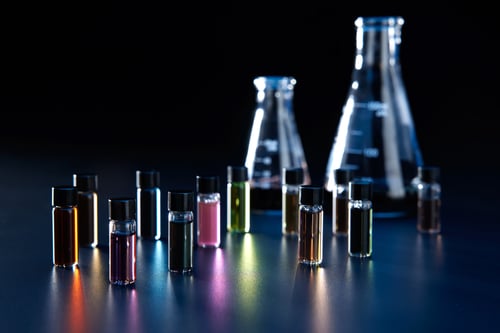
Experimental and theoretical studies of colloidal nanoparticles have primarily focused on accurate characterization and simulation of observable characteristics, such as resonant wavelength. In this paper, we tackle the optimal design of colloidal-nanoparticle ensembles: what is the largest possible per-volume optical cross-section, which designs might achieve them, and can such response be experimentally demonstrated? We combine theory and experiment to answer each of these questions. We derive general bounds on the maximum cross-sections per volume, and we apply an analytical antenna model to show that resonant nanorods should nearly achieve such bounds. We use a modified seed-mediated synthesis approach to synthesize ensembles of gold nanorods with small polydispersity, i.e., small variations in size and aspect ratio. Polydispersity is the key determinant of how closely such ensembles can approach their respective bounds yet is difficult to characterize experimentally without near-field measurements. We show that a certain “extinction metric,” connecting extinction cross-section per volume with the radiative efficiencies of the nanoparticles, offers a quantitative prediction of polydispersity via quantities that can be rapidly measured with far-field characterization tools. Our predictions apply generally across all plasmonic materials and offer a roadmap to the largest possible optical response of nanoparticle ensembles.
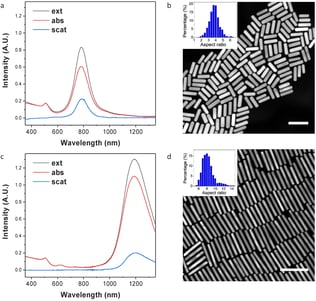
Image Caption: Representative results of optical and structural characterization of Aura Gold Nanorods (AuNR). (a) Extinction, absorption and scattering cross-sections of AuNR ensemble 5 (mean aspect ratio of 3.7) and (b) a representative STEM image. The inset shows the distribution of aspect ratios. (c) Extinction, absorption and scattering cross-sections of AuNR ensemble 10 (mean aspect ratio of 7.7), alongside (d) a representative STEM image. For both STEM images the scale bar is 100 nm.
Citation: Miller, O., Park, K., & Vaia, R. A. (2022). Towards maximum optical efficiency of ensembles of colloidal nanorods. Optics Express, 30(14), 25061-25077.
The study of relationships between order and disorder in materials across length scales has been an active topic of research in materials science and finds roots in many natural structures. In addition to ordered structures, exotic disordered states such as those exhibited in hyperuniform materials are also of recent interest. Hyperuniformity in two phase materials is defined by the presence of local disorder, in this respect similar to amorphous materials, but also with highly suppressed long range density fluctuations, similar to crystals. In the field of nanocomposite materials, the particle packing is an important parameter that can be altered to improve or control material properties. With their negligible density fluctuations at long length scales, hyperuniform packing structures exhibit efficient control of electromagnetic and/or mechanical waves. Here we demonstrate the fabrication of hyperuniform polymer grafted nanoparticle thin films using additive polymer processing techniques and characterize their resulting mechanical properties. The degree of hyperuniformity is then correlated to the mechanical properties of the composite determined by Brillouin light scattering and crazing experiments on lattice supports. At fixed polymer molecular weight we find that a bimodal distribution of gold nanoparticle diameters could be used to influence the strength of hyperuniformity. The concepts applied here are expected to influence the design of future component-level materials and structures.
Citation: Long, D., Ouweleen, M., Drake, A., Park, K., Auguste, A., Gillman, A., & Drummy, L. (2023). Hyperuniform Structure in Polymer-Grafted Nanoparticle Assemblies. Bulletin of the American Physical Society.
Plasmon-mediated chiroptical second harmonic generation from seemingly achiral gold nanorods
Throughout nature, simple rules explain complex phenomena, such as the selective interaction of chiral objects with circularly polarized light. Here, we demonstrate chiroptical signals from gold nanorods, which are seemingly achiral structures. Shape anisotropy due to atomic-level faceting and rounding at the tips of nanorods, which are free of chiral surface ligands, induces linear-to-circular polarization modulation during second harmonic generation. The intrinsic nanorod chiroptical response is increased by plasmon-resonant excitation, which preferentially amplifies circularly polarized harmonic signals. This structure–plasmon interplay is uniquely resolved by polarization-resolved second harmonic generation measurements. The material’s second-order polarizability is the product of the structure-dependent lattice-normal susceptibility and local surface plasmon field vectors. Synthetically scalable plasmon-supporting nanorods that amplify small circular dichroism signals provide a simple, assembly-free platform for chiroptical transduction.
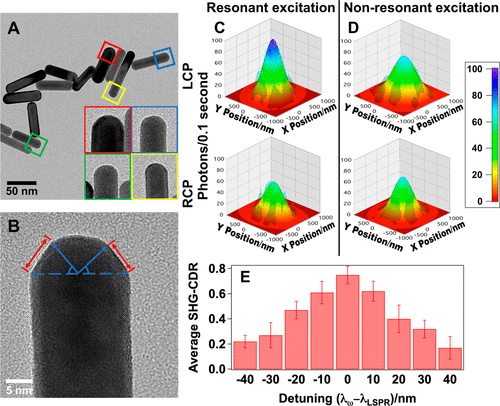
Image Caption: Figure 1. Characterization of gold nanorod shape anisotropy and chiroptical signals. (A) TEM imaging survey of multiple nanorods showing particle-to-particle variations in tip anisotropy (inset). (B) HRTEM image of one nanorod tip. The tip anisotropy is depicted by the double-sided red arrows and the distinctly different bisecting angles (blue). (C,D) Schematic of raw second harmonic generation (SHG) data with an overlay of 3-D Gaussian point spread functions obtained from a single nanorod when the left (top) and right (bottom) circularly polarized laser pulses are resonant (C) and nonresonant (D) with the 800 nm longitudinal surface plasmon resonance of the particle. The resonant (C) and nonresonant (D) data were obtained using fundamental wavelengths of 800 and 690 nm, respectively. The data in (D) produce a circular dichroism ratio (CDR) value of 0.28 ± 0.05, reflecting the intrinsic chiroptical response of the asymmetric nanorod. Plasmon-resonant excitation (C) increased the CDR value to 0.67 ± 0.08. Mean and standard deviations of SHG-detected CDRs (described in main text) obtained for a single nanorod by tuning the wavelength from 760 to 840 nm. The number of photons used for calculating the CDR value was determined to 2−σ confidence. The data plotted in panel (E) reflect the mean and standard deviations from repeating measurements at each wavelength in triplicate.
Citation: Li, Z., Kang, L., Lord, R. W., Park, K., Gillman, A., Vaia, R. A., ... & Knappenberger Jr, K. L. (2021). Plasmon-mediated chiroptical second harmonic generation from seemingly achiral gold nanorods. ACS Nanoscience Au, 2(1), 32-39.
Coexistence and Phase Behavior of Solvent–Polystyrene-Grafted Gold Nanoparticle Systems
Polymer-grafted nanoparticles (PGNs) are widely used as additives or as single-component assemblies in numerous technologies, spanning from composites and coatings to membranes, optical elements, and printable electronics. How the design modularity of PGNs relates to their dispersibility and morphology in thermal or poor solvents, however, is not well established. Herein, we provide experimental volume fraction (ϕ)–temperature (T) coexistence curves (ϕCE and TCE) for polystyrene-grafted gold nanoparticles (PS-AuNPs) in solvents of various qualities (cyclohexane, cyclopentane, and ethyl acetate) using a combination of UV–vis spectroscopy and small-angle X-ray scattering. These systems exhibit upper critical solution temperatures, with coexistence curves that are broader and shifted to lower temperatures relative to their polymer analogs, consistent with prior reports of the impact of macromolecular branching. The coexistence curves span over 6 orders of magnitude in concentration, exhibit solvent-rich and solvent-poor arms that are ϕPGN-dependent, display a reduction in critical temperature (TC*) as graft molecular weight decreases, exhibit an overall narrowing of the solvent-poor arm at higher graft molecular weights, and reveal a minimal influence of core nanoparticle volume (900–4200 nm3). Additionally, the structure within the solvent swollen PS-AuNPs aggregates is disordered or face-centered cubic and depends on the aggregation temperature relative to TC* than on solvent characteristics. Such quantification of PGN phase behavior in thermal or poor solvents is used to demonstrate thermal fraction for purification and will inform future synthesis methods, self and directed assembly techniques, film and fiber processing, and formulation of inks, adhesives, thermosets, and coatings.
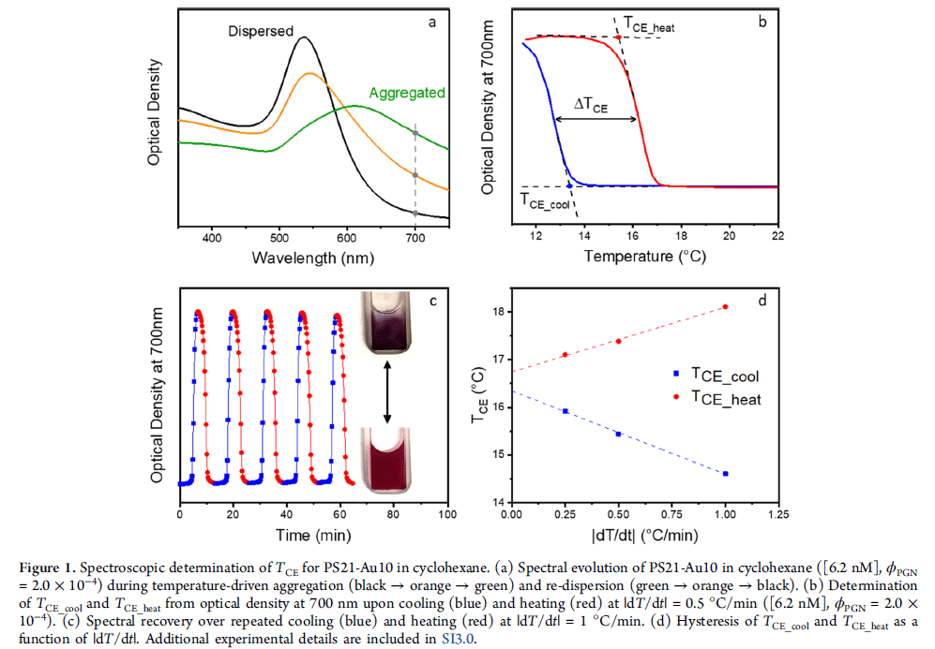
Citation: Izor, S., Schantz, A., Jawaid, A., Grabowski, C., Dagher, T., Koerner, H., ... & Vaia, R. (2021). Coexistence and Phase Behavior of Solvent–Polystyrene-Grafted Gold Nanoparticle Systems. Macromolecules, 54(22), 10435-10446.
Tuning hierarchical order and plasmonic coupling of large-area, polymer-grafted gold nanorod assemblies via flow-coating
Solution-based printing of anisotropic nanostructures is foundational to many emerging technologies, such as energy storage devices, photonic elements, and sensors. Methods to rapidly (>mm/s) manufacture large area assemblies (≫cm2) with simultaneous control of thickness (<10 nm), nanoparticle spacing (<5 nm), surface roughness (<5 nm), and global and local orientational order are still lacking. Herein, we demonstrate such capability using flow-coating to fabricate robust, self-supporting mono- and bilayer films of polystyrene-grafted gold nanorods (PS-AuNRs) onto solid substrates. The relationship among solvent evaporation, deposition speed, substrate surface energy, concentration, and film thickness for solutions of such hairy hybrid nanoparticles spans the Landau–Levich and evaporative film formation regimes. In the Landau–Levich regime, solvent evaporation rapidly concentrates the PS-AuNRs, leading to the formation of thin films with distinct, randomized side-by-side domains. Alternatively, processing at slower velocities in the evaporative regime results in the global alignment of PS-AuNRs. Processing speed and substrate surface energy afford tuning of the film’s optical extinction of a given PS-AuNR via fine control of inter-rod distance and subsequent plasmonic coupling between neighboring nanorods. Because the concept of the polymer-grafted nanorod can be expanded to a variety of different polymer canopies, shapes, and core materials, the processing–structure relationships established in this work will have important implications on the future development of anisotropic nanostructure-based applications.
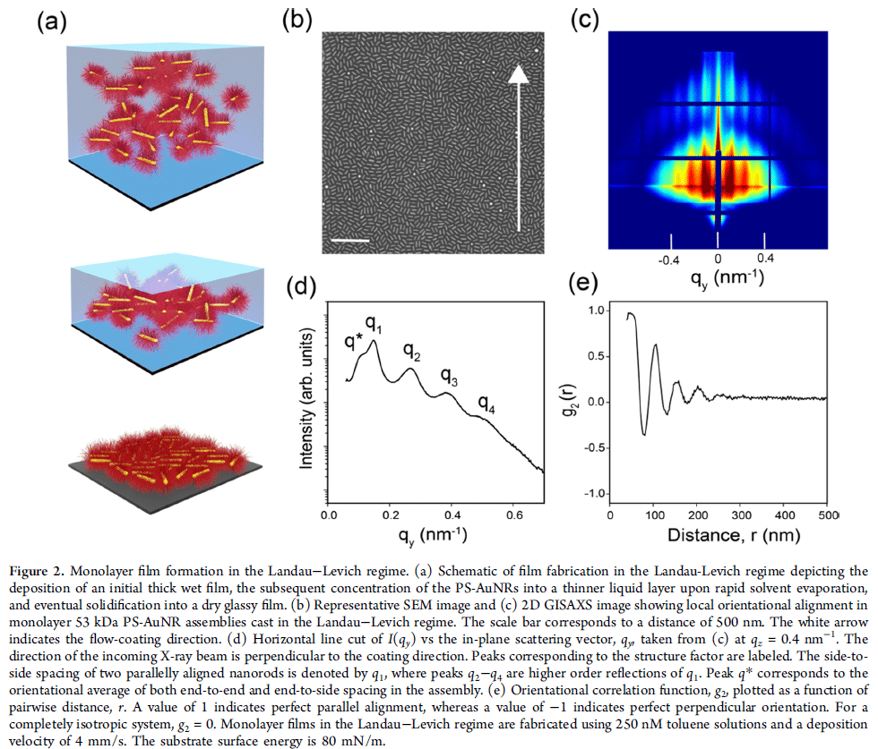
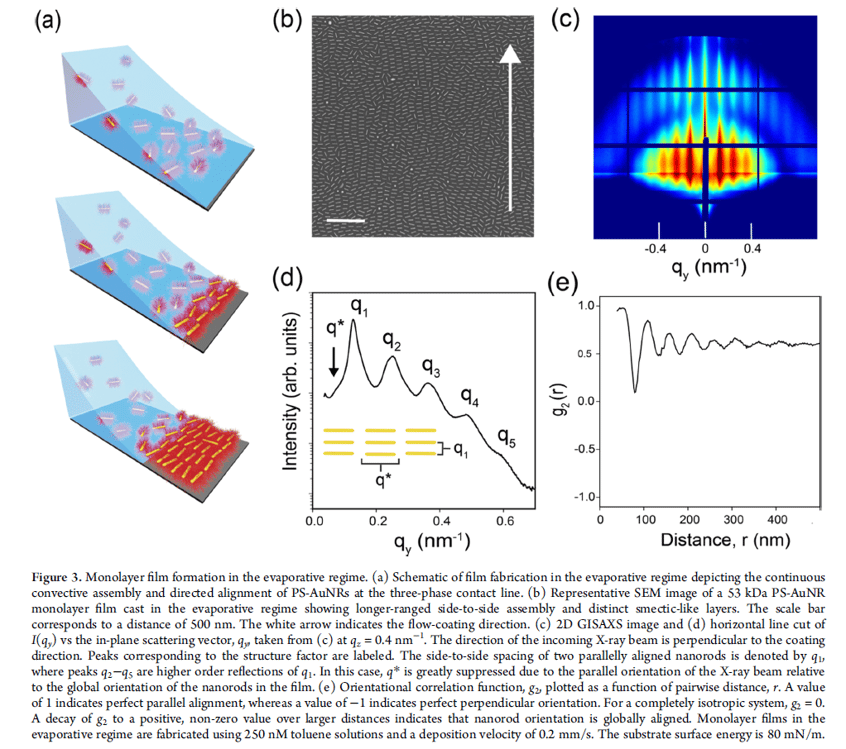
Citation: Streit, J. K., Park, K., Ku, Z., Yi, Y. J., & Vaia, R. A. (2021). Tuning hierarchical order and plasmonic coupling of large-area, polymer-grafted gold nanorod assemblies via flow-coating. ACS Applied Materials & Interfaces, 13(23), 27445-27457.
Connect with us on Facebook, Twitter, LinkedIn, and Instagram.
Want to talk about how AURA's potential can be useful for your specific application? Contact us below or leave a comment!

